|
Brought to you by Dairy's Professional Development Organization®
|
|
Opportunities to learn...

ONGOING WORLD CLASS WEBINAR SERIES SHOWCASES WEATHER
and its impact on your cows, crops and bottom line. Two more sessions will be presented by Eric Snodgrass, director of Undergraduate Studies for the Department of Atmospheric Sciences at the University of Illinois at Urbana Champaign. The May 17 session will focus on correlating severe weather with U.S. grain markets, exploring the best tools available to monitor and predict hail, straight-line winds, floods and tornadoes. Participants will learn how to use quick and simple web resources that alert users to potential severe-weather events. Register today for one session or both the May and the June session, scheduled for June 14. Both sessions are from 12:00 p.m. CST to 1:00 p.m. For more information go to
www.pdpw.org
or call PDPW at 800-947-7379
 SAVE THE DATE FOR WATER TOURS THIS JUNE SAVE THE DATE FOR WATER TOURS THIS JUNE in the Marshfield/Stevens Point and River Falls, Wis. areas. In conjunction with UW-Discovery Farms, PDPW is sponsoring these 1-day tours June 21 and 22 to showcase how current regulations impact farms, towns, municipalities, reservations, businesses and families. Tour participants will learn how these diverse stakeholders use science, engineering and management to achieve common goals. Attend to hear from community leaders, researchers, farmers and other key opinion leaders as they discuss water quality topics and learn how the various entities invest in water quality. This program is open to the public. More details coming in the weeks ahead.
DAIRY ADVANCE IS YOUR ONE-STOP SHOP where dairy producers can access training information for free. A wide range of vetted, high-quality dairy education, training programs, workshops and accredited continuing education (CE) opportunities are available at
www.dairyadvance.org
. The online resource makes it easy for farmers and on-farm team members to track CE credits and advancement toward professional development goals on topics such as animal care, human resources, financial management, environmental stewardship and more. Dairy AdvanCE includes a function to print CE transcripts so farmers can demonstrate their commitment to continuous improvement in their business plans shared with lenders and partners.
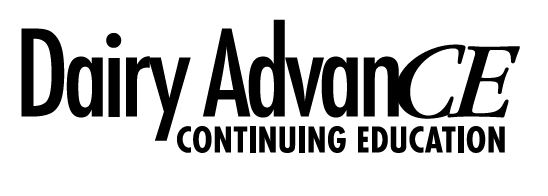
While PDPW developed Dairy AdvanCE with farmers in mind, anyone in the dairy industry can subscribe, including allied industry professionals such as veterinarians, nutritionists, technicians, field and sales representatives, as well as food system, legal and public service professionals.
To learn more or subscribe to Dairy AdvanCE email mail@dairyadvance.org, or call 800-947-7379.
|
For your dairy...
 INCREASED COMPETITION AT THE FEED BUNK CAN IMPACT PRODUCTION
according to results of research published online in the Journal of Dairy Science. Researchers at the University of Guelph in Canada monitored the behavior and productivity in cows in three groups: high, medium and low competition levels for feed. They found that at elevated competition levels, cows modify their feeding behavior to consume feed in a shorter period and devote a large portion of their mealtime toward waiting to gain feed access, resulting in reduced daily lying time. Furthermore, meal patterns and milk production vary greatly within groups of cows at high levels of competition for feed access. Read more about the study
here
. INCREASED COMPETITION AT THE FEED BUNK CAN IMPACT PRODUCTION
according to results of research published online in the Journal of Dairy Science. Researchers at the University of Guelph in Canada monitored the behavior and productivity in cows in three groups: high, medium and low competition levels for feed. They found that at elevated competition levels, cows modify their feeding behavior to consume feed in a shorter period and devote a large portion of their mealtime toward waiting to gain feed access, resulting in reduced daily lying time. Furthermore, meal patterns and milk production vary greatly within groups of cows at high levels of competition for feed access. Read more about the study
here
.
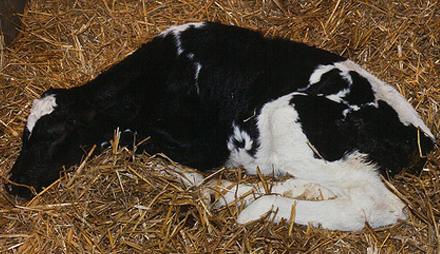 LACTOFERRIN CAN REDUCE MORTALITY IN CALVES WITH DIARRHEA
indicates research recently published in the Journal of Dairy Science. The objectives of the study were to determine the effectiveness of lactoferrin as well as garlic extract to reduce mortality and culling, improve weight gain, and reduce the duration of disease in preweaned calves with the first diagnosis of diarrhea. In total, 628 calves with diarrhea from a single commercial dairy were enrolled in a blinded, randomized field trial. Calves diagnosed with diarrhea were randomized to 3 consecutive days of oral garlic extract, lactoferrin, or water (control). For calves receiving garlic extract, the risk of death or culling was not significantly different than calves in the control group; however, calves that received lactoferrin had approximately half the risk of death or culling in the 120 days following diagnosis. Additional studies conducted across multiple farms are necessary to corroborate results; if confirmed, lactoferrin may become an important tool to improve treatment outcomes and reduce the necessity of antimicrobials. Click
here
for more details. LACTOFERRIN CAN REDUCE MORTALITY IN CALVES WITH DIARRHEA
indicates research recently published in the Journal of Dairy Science. The objectives of the study were to determine the effectiveness of lactoferrin as well as garlic extract to reduce mortality and culling, improve weight gain, and reduce the duration of disease in preweaned calves with the first diagnosis of diarrhea. In total, 628 calves with diarrhea from a single commercial dairy were enrolled in a blinded, randomized field trial. Calves diagnosed with diarrhea were randomized to 3 consecutive days of oral garlic extract, lactoferrin, or water (control). For calves receiving garlic extract, the risk of death or culling was not significantly different than calves in the control group; however, calves that received lactoferrin had approximately half the risk of death or culling in the 120 days following diagnosis. Additional studies conducted across multiple farms are necessary to corroborate results; if confirmed, lactoferrin may become an important tool to improve treatment outcomes and reduce the necessity of antimicrobials. Click
here
for more details.
 GET THE MOST OUT OF YOUR SPRAYER THIS SEASON GET THE MOST OUT OF YOUR SPRAYER THIS SEASON
with tips provided by Ohio State University Extension. As margins continue to be tight, it's critical to maximize your inputs and effectively manage your time. Start by ensuring that your sprayer is calibrated and operating accurately, then re-calibrate the sprayer periodically to maintain peak performance. Also, check the type of nozzles and how they should be set or overlapped to ensure complete coverage and make sure they aren't clogged. Setting the proper boom height for a specific nozzle spacing is also important to achieve proper overlapping. Carry extra nozzles, washers, other spare parts and tools to repair simple problems quickly in the field. Finally, be safe by reading and following chemical and equipment instructions and wearing protective clothing, rubber gloves and respirators when calibrating the sprayer, spraying and cleaning the equipment. Find more details
here.
 IS OVERMILKING A PROBLEM ON YOUR FARM?
A simple test can help you determine whether cows are being milked too long. Though it's traditionally been recommended to milk all cows as completely as possible at every milking, revisions to this standard have been made based on research that shows it's impossible to completely milk out a cow because she's constantly making milk. Furthermore, overmilking can damage teat-end health and lead to hyperkeratosis, putting cows at greater risk for infection. How can you determine if overmilking is occurring on your dairy? Hand-strip each quarter for 15 seconds, collecting the milk in a container. A properly milked cow should have about one cup of milk left in the udder. The test can also be performed with a milking meter. For more information, read the full article from Penn State University Extension
here
. IS OVERMILKING A PROBLEM ON YOUR FARM?
A simple test can help you determine whether cows are being milked too long. Though it's traditionally been recommended to milk all cows as completely as possible at every milking, revisions to this standard have been made based on research that shows it's impossible to completely milk out a cow because she's constantly making milk. Furthermore, overmilking can damage teat-end health and lead to hyperkeratosis, putting cows at greater risk for infection. How can you determine if overmilking is occurring on your dairy? Hand-strip each quarter for 15 seconds, collecting the milk in a container. A properly milked cow should have about one cup of milk left in the udder. The test can also be performed with a milking meter. For more information, read the full article from Penn State University Extension
here
.
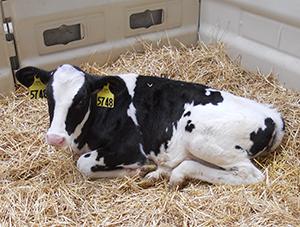 HEAT STRESS DURING PREGNANCY AFFECTS CALVES AFTER BIRTH HEAT STRESS DURING PREGNANCY AFFECTS CALVES AFTER BIRTH with impacts on immunity, growth and activity patterns. A research study evaluated the health, growth, and activity patterns of calves born to cows exposed to heat stress and those provided with cooling resources such as fans, soakers, shade, etc. At birth, calves of cows in the cooled group were heavier and had healthier (lower) body temperatures. The same group spent more time standing in the first week of life and gained .2 kg per day more from birth to weaning. Click
here to learn more from the Journal of Dairy Science article.
|
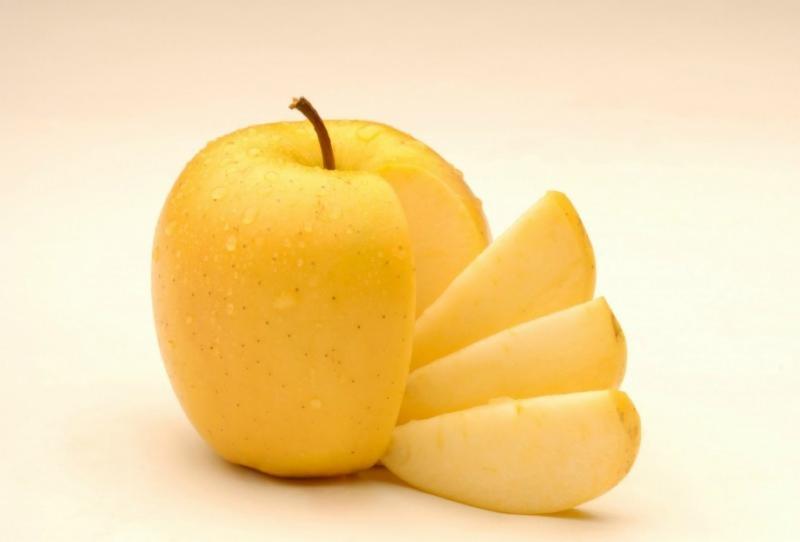 ARCTIC APPLE SET TO GO ON SALE in the United States and could serve as a turning point in the debate over genetically modified food. The non-browning apple is to be test marketed in Midwestern grocery stores and will be sold sliced. Both critics and advocates of biotechnology will be watching the introduction of this new product closely, with proponents saying its success could encourage the development and deregulation of other foods such as an engineered pink pineapple with lycopene and a purple tomato that has extra antioxidants. Read more in this article. ARCTIC APPLE SET TO GO ON SALE in the United States and could serve as a turning point in the debate over genetically modified food. The non-browning apple is to be test marketed in Midwestern grocery stores and will be sold sliced. Both critics and advocates of biotechnology will be watching the introduction of this new product closely, with proponents saying its success could encourage the development and deregulation of other foods such as an engineered pink pineapple with lycopene and a purple tomato that has extra antioxidants. Read more in this article.
DOES FOOD PRODUCTION REALLY NEED TO DOUBLE BY 2050? A common belief about feeding the world's growing population has been called into question by recent research. A study published in Bioscience suggests that food production will need to increase between 25% and 70% to meet demand by 2050, but not double as many experts and academics have stated. One of the study's authors also stated that "food production and environmental protection must be treated as equal parts of agriculture's grand challenge." Read more
here.
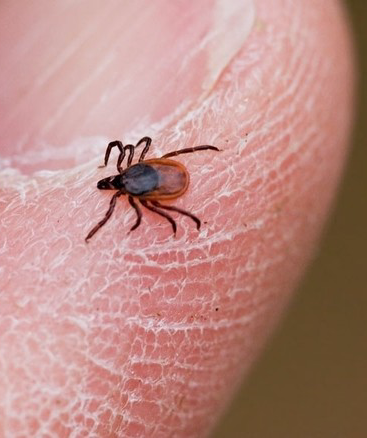 PREVENTING TICK-BORNE ILLNESSES SHOULD BE TOP PRIORITY PREVENTING TICK-BORNE ILLNESSES SHOULD BE TOP PRIORITY during spring season. As weather warms, new grass and brush areas offer places for ticks to come into contact with humans and potentially transmit a number of diseases. Tick bites are often painless at first and most people are not aware they have been bitten, so checking yourself immediately after being in an infested area is important. A few tick prevention tips include:
- Use effective tick repellents and apply according to the label instructions.
- Wear long sleeves, long pants and long socks to keep ticks on the outside of clothing.
- Tuck shirts into pants and pants into shoes or socks to keep ticks on the outside of clothing. If outdoors for an extended period of time, tape pant legs where pants and socks meet so that ticks cannot crawl under clothes
-
Attached ticks should be immediately removed with fine-tipped tweezers, grasping the tick as close to the skin as possible.
For more information on preventing and controlling tick-borne diseases, click here.
 A NEW STRATEGIC PLAN FOR THE NATION'S FOOD SAFETY
was issued by the Interagency Food Safety Analytics Collaboration (IFSAC) to focus on continuing to improve estimates of the sources of foodborne illnesses and developing methods to estimate how these sources change over time. IFSAC was created in 2011 to improve coordination of federal food safety analytic efforts between the U.S. Food and Drug Administration (FDA), Centers for Disease Control and Prevention (CDC), and the U.S. Department of Agriculture's (USDA) Food Safety and Inspection Service (FSIS). The goals of the new strategic plan are to improve the use and quality of data sources, improve analytic methods and models, and enhance communication about IFSAC progress. By bringing together data from CDC, FDA, and FSIS, and by developing sound analytical methods, IFSAC scientists can improve estimates of the sources of foodborne illnesses that most commonly occur. Learn more about the plan and collaboration on its
website
. A NEW STRATEGIC PLAN FOR THE NATION'S FOOD SAFETY
was issued by the Interagency Food Safety Analytics Collaboration (IFSAC) to focus on continuing to improve estimates of the sources of foodborne illnesses and developing methods to estimate how these sources change over time. IFSAC was created in 2011 to improve coordination of federal food safety analytic efforts between the U.S. Food and Drug Administration (FDA), Centers for Disease Control and Prevention (CDC), and the U.S. Department of Agriculture's (USDA) Food Safety and Inspection Service (FSIS). The goals of the new strategic plan are to improve the use and quality of data sources, improve analytic methods and models, and enhance communication about IFSAC progress. By bringing together data from CDC, FDA, and FSIS, and by developing sound analytical methods, IFSAC scientists can improve estimates of the sources of foodborne illnesses that most commonly occur. Learn more about the plan and collaboration on its
website
.
|
For your business mind...
ADVANCED PLANNING AND UPDATED RECORDS ARE KEY TO QUICK RECOVERY after a natural disaster or other devastating property loss, according to a publication from Kansas State University. An itemized inventory of household, business and farm belongings will help you work with insurance providers to determine needed coverage and will be an invaluable resource in identifying losses after a disaster. Consider storing a copy of this list off-site, in case of total loss by tornado, fire, or other cause.
The authors also suggest compiling a "Grab and Go" kit that can be accessed quickly in case of evacuation. Some of the items on the list include:
- Identification and key documents to restore financial records, including copies of driver's license, passports, social security cards, etc.
- Insurance cards, policies or other proof of insurance coverage
- Household inventory
- Bank account numbers
- Phone numbers and account information for all financial service and insurance providers
- Important telephone numbers (family members, doctors, veterinarians)
Download the publication with more tips
here
.
 FINDING WAYS TO COPE WITH STRESS FINDING WAYS TO COPE WITH STRESS will deliver long-term benefits. Farm business owners face many situations that are outside the realm of prediction or control. In combination with work demands, financial stressors and family obligations, it's natural to feel overwhelmed, but developing healthy ways to control stress can improve the ability to tackle business challenges. An article from Fortune magazine provides 15 ways to help cope with business stress without sacrificing health or relationships, including:
- Increase your endorphin production with exercise or a quick walk
- Pay attention to what nutrition you're putting in your body - fuel up with proteins, fruits, vegetables and healthy fats that regulate hormone levels; and avoid junk food
- Keep a gratitude journal to help you stay focused on even the smallest positives
- Surround yourself with positive and encouraging people
- Be of service to someone
Read the full list with descriptions here.
FEELING LIKE THERE IS MORE TO ACCOMPLISH? According to research at Stanford University, commonly feeling a bit short of success can be an indicator that you'll continue driving toward new accomplishments.
The key, according to study authors
, is to not compare your position to that of others, but instead to focus on your own standards by assessing if you're performing with as much dedication and effort as you've done previously. Read the full Inc. article
here
.
|
Courage is not having the strength to go on; it is going on when you don't have the strength.
--Theodore Roosevelt (1858-1919), 26th President of the United States
|
 CONTAGIOUS: WHY THINGS CATCH ON
Wharton marketing professor and author Jonah Berger has spent the last decade studying why things become popular or "catch on" more than others, and how social influence shapes everything from the cars we buy to the clothes we wear to the names we give our children. Contagious provides a set of specific, actionable techniques for helping information spread-for designing messages, advertisements, and content that people will share. Whether you're looking for new ideas to communicate with employees or share positive information about your farm with neighbors or community members, this book may provide valuable insights. CONTAGIOUS: WHY THINGS CATCH ON
Wharton marketing professor and author Jonah Berger has spent the last decade studying why things become popular or "catch on" more than others, and how social influence shapes everything from the cars we buy to the clothes we wear to the names we give our children. Contagious provides a set of specific, actionable techniques for helping information spread-for designing messages, advertisements, and content that people will share. Whether you're looking for new ideas to communicate with employees or share positive information about your farm with neighbors or community members, this book may provide valuable insights.
|
|
A BIG Thank You...
TO OUR PDPW SPONSORS who
support continuous improvement for the dairy industr
y.
T
hey believe in producer leadership and place a high value on lifelong
education for those involved in the dairy industry. We deeply respect their commitment to PDPW and the members we have the honor to serve. It is by this partnership that we c
ontinu
e to build a strong industry filled with capable professionals. Click
HERE
to see a list of our sponsors. If you interact with any of these companies, please thank them for supporting PDPW!
If you or a company you know is interested in participating as a sponsor, please contact one of our team members at abonomie@pdpw.org or call 800-947-7379.
|
|
PDPW Education Calendar
| May 17 |
PDPW World Class Webinars - "Weather: more than a guess - Correlating Severe Weather and U.S. Grain Markets"
|
| June 14 |
PDPW World Class Webinars - "Weather: more than a guess - Weather Outlook for Summer and Fall"
|
STAY CONNECTED
800-947-7379
|
|
|
|
|